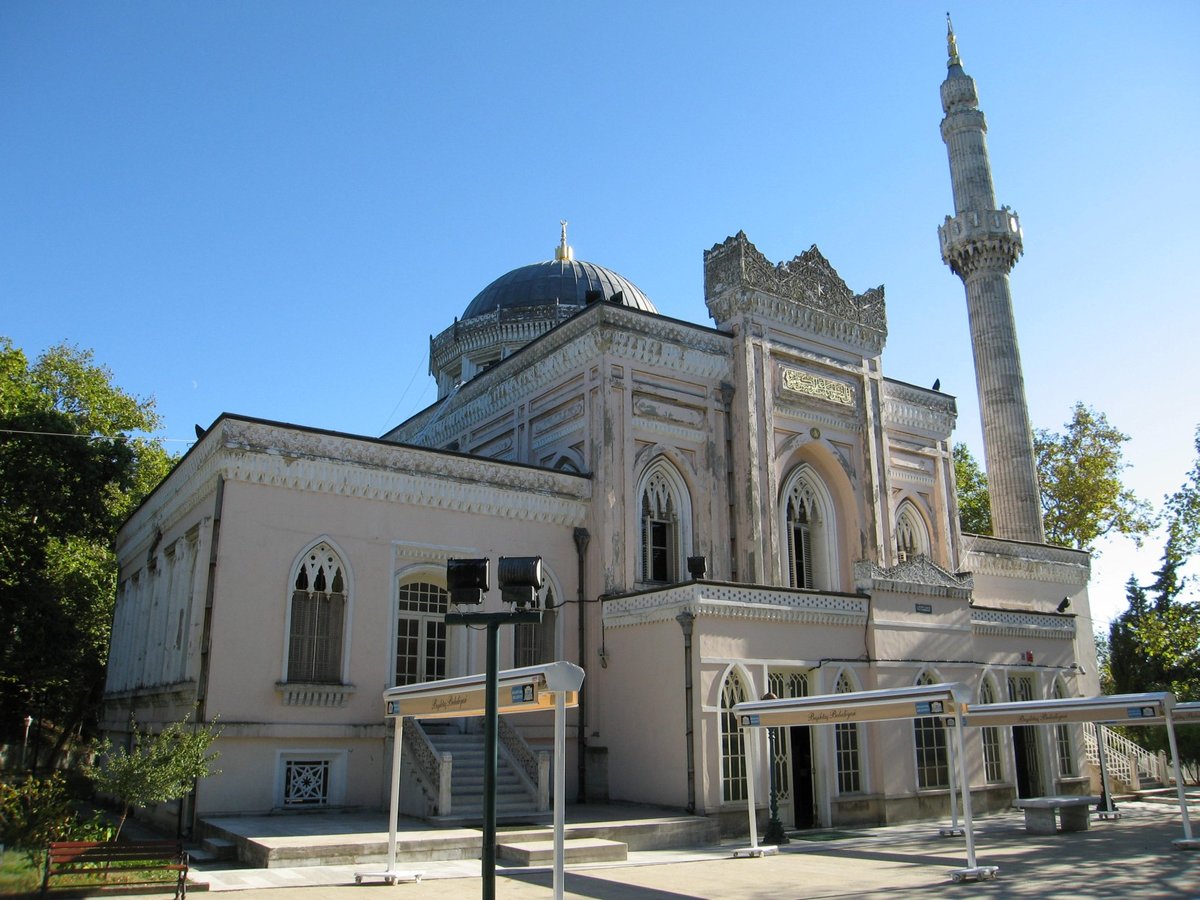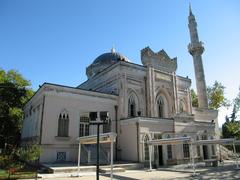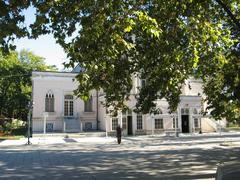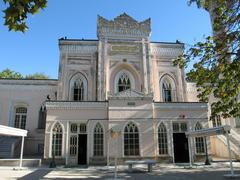
Yıldız Hamidiye Mosque Visiting Hours, Tickets, and Istanbul Historical Sites Guide
Date: 14/06/2025
Introduction: History and Significance of Yıldız Hamidiye Mosque
Nestled in Istanbul’s historic Beşiktaş district, the Yıldız Hamidiye Mosque stands as a vivid testament to the late Ottoman Empire’s architectural ambition and imperial symbolism. Commissioned by Sultan Abdülhamid II between 1884 and 1886, it fuses classic Ottoman mosque design with Neo-Gothic and Orientalist influences, reflecting the empire’s modernization and engagement with Western styles during a pivotal era. Situated within the grounds of Yıldız Palace—the Sultan’s residence and the administrative heart of the empire—the mosque served both as a sanctuary for worship and a symbol of imperial authority.
Designed by renowned Armenian-Ottoman architect Sarkis Balyan, the mosque features a striking rectangular plan, a single minaret, and a high entrance dome illuminated by sixteen Neo-Gothic windows. Its interior is adorned with exquisite tilework, calligraphy, and intricate woodwork, showcasing the era’s masterful craftsmanship.
Historically, the mosque was central not just to religious life but also to political events—most notably surviving a 1905 assassination attempt on Sultan Abdülhamid II. Today, Yıldız Hamidiye Mosque remains an active place of worship and a protected heritage site, welcoming visitors eager to explore Istanbul’s layered history and architectural heritage.
Visitors enjoy free admission, with daily visiting hours typically from 9:00 AM to 5:00 PM, except during prayer times and religious holidays. Guided tours, accessible facilities, and proximity to landmarks like Yıldız Palace, Yıldız Park, and Dolmabahçe Palace enhance the visitor experience. Ongoing restoration efforts, most recently completed in 2017, have preserved the mosque’s structural and decorative integrity for future generations. (Istanbul Travel, Istanbul Metropolitan Municipality Heritage Page, Istanbul.com)
Table of Contents
- History and Commissioning of Yıldız Hamidiye Mosque
- Political and Cultural Context
- Architectural & Artistic Highlights
- Historical Events and Significance
- Visiting Yıldız Hamidiye Mosque: Hours, Tickets, and Tips
- Restoration and Preservation
- The Mosque’s Place Among Istanbul’s Historical Sites
- Nearby Attractions
- Frequently Asked Questions
- Visual Gallery & Multimedia
- Conclusion and Recommendations
1. History and Commissioning
Commissioned by Sultan Abdülhamid II, the Yıldız Hamidiye Mosque—completed in 1886—was conceived during a period of sweeping modernization and political tension in the Ottoman Empire. Its location within the Yıldız Palace complex, then the epicenter of imperial administration, reflected the Sultan’s intent to blend religious devotion with political power. The mosque’s title, “Hamidiye,” further alludes to the Hamidiye Regiments, underlining its dual spiritual and imperial significance.
2. Political and Cultural Context
The late 19th century brought significant change to the Ottoman Empire, with internal reforms and external pressures prompting efforts to modernize while preserving Islamic and Ottoman identity. The construction of Yıldız Hamidiye Mosque exemplified these aims, serving as both the Sultan’s private mosque and a stage for state ceremonies and diplomatic gatherings. Its integration within the palace grounds physically united religious practice with imperial authority.
3. Architectural & Artistic Highlights
Style Fusion:
Yıldız Hamidiye Mosque is a distinctive blend of classical Ottoman architecture and Neo-Gothic motifs. Architect Sarkis Balyan’s design features a rectangular plan, a single elegant minaret, and a high drum dome near the entrance—a unique arrangement for imperial mosques.
Natural Light & Ornamentation:
Sixteen Neo-Gothic windows fill the prayer hall with natural light, illuminating ornate tilework, wood carvings, and calligraphic panels. The mosque’s exterior boasts sophisticated stonework, while the interior’s stained glass windows and painted floral motifs echo both Ottoman and Western influences. (Istanbul.com)
Clock Tower:
A distinctive clock tower, added in the 1890s, stands in the courtyard, symbolizing the late Ottoman embrace of technological modernization.
4. Historical Events and Significance
The mosque gained political notoriety as the site of a 1905 assassination attempt on Sultan Abdülhamid II, surviving thanks to a delay in his exit. This event cemented the mosque’s place in late Ottoman history, underscoring its association with imperial authority and resilience during turbulent times.
5. Visiting Yıldız Hamidiye Mosque: Hours, Tickets, and Tips
- Visiting Hours: Open daily from 9:00 AM to 5:00 PM, except during prayer times and religious holidays.
- Entrance Fee: Admission is free; donations are appreciated.
- Guided Tours: Available through select tour operators and during cultural events.
- Dress Code: Modest attire is required. Women should cover their heads and shoulders; men should avoid shorts. Scarves are often available at the entrance.
- Etiquette: Remove shoes before entering, maintain silence, and avoid photography during prayers. Respect all signage and worshippers’ privacy. (Forbes, The Istanbul Insider)
- Accessibility: The main entrance is wheelchair accessible, though some areas may have steps or uneven surfaces.
6. Restoration and Preservation
Major restoration, completed in 2017, revitalized the mosque’s structural and decorative features, safeguarding its legacy as both a place of worship and a historical landmark. These efforts have ensured the preservation of its tilework, stained glass, and calligraphic elements. (Istanbul Metropolitan Municipality Heritage Page)
7. The Mosque’s Place Among Istanbul’s Historical Sites
While less grandiose than the Blue Mosque or Hagia Sophia, Yıldız Hamidiye Mosque’s unique design and late Ottoman context make it a vital piece of Istanbul’s architectural and cultural heritage. It is recognized as the last selatin (imperial) mosque built in the empire, symbolizing the culmination of centuries of Ottoman mosque construction.
8. Nearby Attractions
- Yıldız Palace: The sultan’s former residence, with guided tours and lush gardens.
- Yıldız Park: A historic urban park, perfect for walks and relaxation (Visit Turkey).
- Dolmabahçe Palace: Renowned for its European-inspired architecture.
- Bosphorus Waterfront: Enjoy scenic vistas and ferry rides.
- Çırağan Palace: Now a luxury hotel with Ottoman grandeur.
9. Frequently Asked Questions
Q: What are the visiting hours?
A: Daily from 9:00 AM to 5:00 PM, except during prayer times and holidays.
Q: Is there an entrance fee?
A: No, admission is free.
Q: Are guided tours available?
A: Occasionally, through local operators or during special events.
Q: Is there a dress code?
A: Yes, modest attire is required; women should cover their heads and shoulders.
Q: Is the mosque accessible?
A: The main entrance is accessible; some areas have steps.
Q: Can I take photographs?
A: Yes, but avoid photographing worshippers or during prayers.
10. Visual Gallery & Multimedia
[High-quality images and virtual tours of Yıldız Hamidiye Mosque are available on official tourism platforms, with captions such as “Yıldız Hamidiye Mosque exterior in Istanbul”, “Interior tilework and stained glass”, and “Courtyard clock tower”.]
Interactive map location
11. Conclusion and Recommendations
Yıldız Hamidiye Mosque encapsulates the intersection of religious devotion, imperial authority, and architectural innovation at the twilight of the Ottoman era. As the last imperial mosque commissioned by Sultan Abdülhamid II, it remains a unique cultural landmark in Istanbul. Its distinctive style—melding Ottoman tradition with Neo-Gothic and Orientalist influences—invites visitors to explore both the beauty and complexity of the empire’s late history.
Strategically located near Yıldız Palace and other notable sites, and offering free admission, the mosque is an inviting destination for both spiritual reflection and historical discovery. Restoration efforts have preserved its artistry for future generations, and practical amenities ensure a smooth visit.
For up-to-date information on visiting hours, cultural events, and guided tours, download the Audiala app and consult official tourism sources. Delve into related articles on Ottoman architecture and Istanbul’s heritage to further enrich your journey.
References
- Yıldız Hamidiye Mosque, Istanbul Travel, 2025
- Istanbul Metropolitan Municipality Heritage Page: Yıldız Hamidiye Mosque, 2025
- The Most Beautiful and Impressive Mosques in Istanbul, Istanbul.com, 2025
- How to Visit a Mosque in Istanbul: An Etiquette Guide, Forbes, 2025
- What Not to Do in a Mosque, The Istanbul Insider, 2025
- Top Things to Do in Istanbul This Year, The Tour Guy, 2025
- Holy Sites of Istanbul: Explore Istanbul’s Fascinating Religious History, Istanbul.tips, 2025
- Istanbul Best Mosques, Istanbulclues.com, 2025
- Top 10 Best Things to Do in Istanbul in June, Istanbeautiful.com, 2025
- Brief History of Istanbul and Its Most Famous Historical Sites, World History Edu, 2025
- Yıldız Parkı Istanbul, Visit Turkey, 2025
- How Much and When to Tip in Istanbul, Istanbul Tips, 2023
























































































































